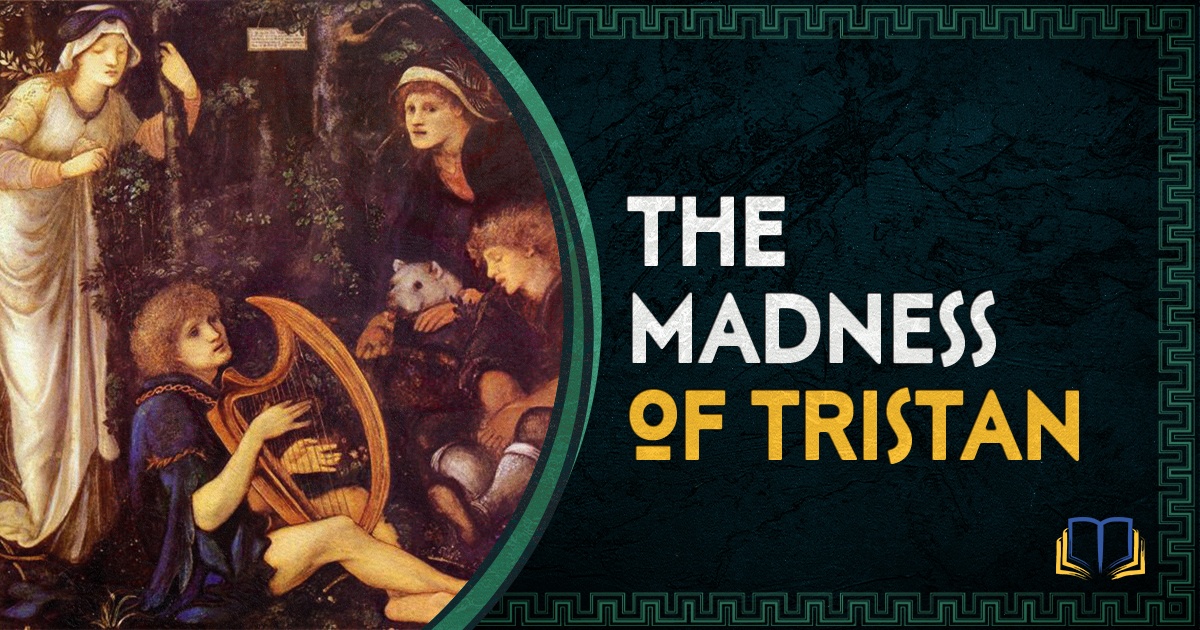According to Joseph Bédier and Frederick Whitehead, Le Folie Trist(r)an d’Oxford is also known as the Oxford Folie Trist(r)an, The Madness of Tristan, and Tristan’s Madness.
It is a poem in 998 eight-syllable lines written in Anglo-Norman (the Norman language spoken in England). Judith Weiss says that Folie Trist(r)an recounts an episode in which Tristran disguises himself as a madman to win his way back to Ysolt (Isolt).
Written between AD 1175 and 1200, the poem’s author is unknown. Joseph Bédier and Samuel N Rosenberg have cautioned: Le Folie Trist(r)an d’Oxford is not to be confused with Le Folie Tristan de Berne. They are different mediæval poems that detail the same subject. Each work takes its name from the city in which the manuscript now resides.
Oxford Folie Trist(r)an “handle[s] with humour, vivacity, and poignant feeling the dramatic possibilities of the theme”, says Frederick Whitehead. Joseph Bédier considered it more beautiful than Le Folie Tristan de Berne. Comparing Le Folie Trist(r)an d’Oxford with its major source, Thomas of Britain’s Tristran(s), Bédier judged that Oxford Folie Trist(r)an equals Thomas’ Tristran(s) in sincerity and intensity of emotion and surpasses it in energy and eloquence.
Le Folie Trist(r)an d’Oxford begins thusly: “Tristran surjurne en sun païs, dolent, murnes, tristes, pensifs. Purpenset soi ke faire pot, kar acun cunfort lu estot …” “Tristan dwelt in his country; doleful, dejected, sad, pensive. He thought about what he could do, for he had no comfort …”
Summary of Plot
Distraught at having lost the love of Ysolt/Isolt, Tristran travels incognito to England to find her. The ship on which he has taken passage lands at the enchanted castle of Tintagel, where King Mark and his queen Ysolt/Isolt hold court.
Tristran disguises himself as a crazed simpleton. In this way, Mark will not kill him because he will not recognise Tristran. Fighting off the bystanders who try to bait him, Tristran gains admittance to King Mark’s hall. Announcing that his name is Trantris, Tristran claims to love Ysolt/Isolt and wants to offer Mark his sister as an exchange for the queen.
The king laughs at the wild words of this supposéd lunatic. Tristran reminds Ysolt/Isolt of various episodes in their past life.
Though he won her hand on Mark’s behalf, Tristran and Ysolt/Isolt fell in love. Ysolt/Isolt angrily denies all knowledge of him. To Mark’s amusement, Tristran boasts that he is a fine huntsman, hawker, and musician.
Ysolt/Isolt retires to her room and complains of the madman to her servant Brenguain/Brangain, who, suspecting the truth, seeks him out.
Tristran persuades Brenguain/Brangain of his true identity, and she takes him back to see Ysolt/Isolt. Again Tristran recalls at length and in detail the life he and Ysolt/Isolt formerly led together as illicit lovers. He speaks of Mark’s discovery of their love and their consequent banishment.
Tristran recounts when his and Ysolt’s/Isolt’s innocence was recognised by Mark. Ysolt’s/Isolt’s incredulity disappears as she hears this, and still, more when her hound Husdent joyfully recognises Tristran. Finally, Tristran produces the ring she once gave him.
She accepts Trantris is indeed her lover Tristran and falls into his arms.
The Manuscript and Its Journey
Tony Hunt and Geoffrey Bromiley tell us that the poem survives in only one manuscript, known as Bodleian Library MS Douce d6 (f12vb-19ra).
This manuscript is from the second half of the 13th Century AD. It contains Folie d’Oxford and a large fragment of Le Roman de Tristran(s) by Thomas of Britain.
Judith Weiss claims the Anglo-Norman scribe was careless. His inferior sense of rhythm led him to overlook his frequent addition or omission of words, resulting in unmetrical lines.
According to Cedric E Pickford and James C Corson, the provenance of MS Douce d6 can be tracked to the 18th–19th-century bibliophile Francis Douce. The first known mention of the MS Douce d6 manuscript is in a letter dated 7 December 1801 from Walter Scott to the antiquary George Ellis.
In 1804, Scott printed a précis (summary/abstract) of the manuscript’s two poems in his edition of the Middle English romance Sir Tristrem. Arthur Johnston and George Ellis tell us that Scott and Ellis each separately published opinions that Sir Tristrem was the source of both Le Folie Trist(r)an d’Oxford and Thomas’ Tristran(s).
Francis Douce believed the French poems were older. In 1838, Francisque Michel edited and published the poem in The Poetical Romances of Tristan in French, Anglo-Norman, and Greek Composed in the XII and XIII Centuries. According to Joseph Bédier, the manuscript now rests in the Bodleian Library, Oxford.
The Resemblance to Other Versions of the Tristan Legend
David J Shirt tells us that the poem is most closely related to Le Folie Tristan de Berne, a shorter and less well-organised treatment of the same subject, and Tristran(s) of Thomas.
The nature of those relationships is dubious. In his edition of Le Folie Tristan de Berne, Ernest Hœpffner claimed the Berne Folie was the source of the Oxford version.
Other scholars have concluded that both derive from some lost third poem. According to Weiss and Bédier, Oxford Folie resembles Thomas’ romance, in particular the ordering of multiple episodes and many of the linguistic characteristics.
These resemblances led Hœpffner to suggest that Thomas might have been the author of Le Folie Trist(r)an d’Oxford. The best explanation is Tristran(s) of Thomas was the main source of Oxford Folie.
Its Source Texts and the Uniqueness of Le Folie Trist(r)an d’Oxford
Tony Hunt and Geoffrey Bromiley claim several minor sources exist.
In the description of Tintagel, there are enough verbal similarities to show that the author had read Roman de Brut by Robert Wace of Jersey.
Judith Weiss sees similarities with Marie de France’s Le Lai du Chèvrefueil(le), and his use of the expression lais bretuns, in line 362, indicates that the poet knew Marie’s lais.
There is also evidence of his having known the romances of Le Roman de Troie (The Romance of Troy), Le Roman d’Enéas (The Romance of Æneas), and Le Roman de Thèbes (The Romance of Thebes).
Weiss continues with the author showing relatively little inclination to make a wonder-tale of the story. Unlike most other British poets of the time, there is a strong interest in romantic love as a theme linked with death. Weiss tells us that the poet explores the idea of love as a form of madness.
Tristran’s assumption of the role of an imbecile as a disguise is only partly deliberate. The author exemplifies the belief that fools may be wiser than those who are sane.
This idea may give voice to truths that would otherwise go unsaid. According to Weiss, the author of Oxford Folie differs from other early Tristan-poets. The courtliness of Tristran is pointed out as well as Tristran’s cruelty toward Ysolt/Isolt.
Conclusion
The poem ends with “Tristran autre chose ne quert fors la raine Ysolt, u (ele) ert. Tristran en est joius e lez: mult set ben k’il est herbigez.” “Tristan sought only the Queen Isolde, no one but her. Tristan was joyous and happy: much being well, he was planted.”
This tells us that Tristan was completely devoted to Isolde. He was, at the poem’s end, content in his attachment to her. The Oxford Folie Trist(r)an recounts the episode in which Tristran disguises himself as a madman (Trantris) to win his way back to Ysolt (Isolt).
Written between AD 1175 and 1200, the poem’s author is unknown. Le Folie Trist(r)an d’Oxford is not to be confused with Le Folie Tristan de Berne. The Oxford Folie Trist(r)an survives in only one manuscript, known as Bodleian Library MS Douce d6 (f12vb-19ra).
This manuscript is from the second half of the 13th Century AD. Tristran(s) of Thomas was the main source of Oxford Folie. The author of Le Folie Trist(r)an d’Oxford had read Roman de Brut by Robert Wace of Jersey.
There are also similarities with Marie de France’s Le Lai du Chèvrefueil(le) and evidence of the author’s familiarity with the romances of Le Roman de Troie, Le Roman d’Enéas, and Le Roman de Thèbes.
The uniqueness of the Oxford Folie Trist(r)an is the courtliness of Tristran as well as Tristran’s cruelty toward Ysolt/Isolt.
Arthurian Bibliography
- Norris Lacy, Geoffrey Ashe, Debra Mancoff – The Arthurian Handbook (Second Edition)
- Alan Lupack – The Oxford Guide to Arthurian Literature and Legend
- Ronan Coghlan – The Illustrated Encyclopaedia of Arthurian Legends
- Anonymous – Lancelot-Grail, the French Vulgate
- Sir Thomas Malory – Le Morte d’Arthur
See also my ever-expanding list of primary and secondary sources.



